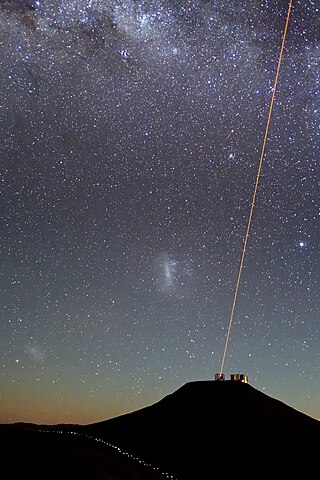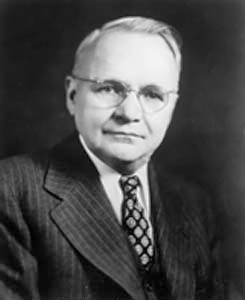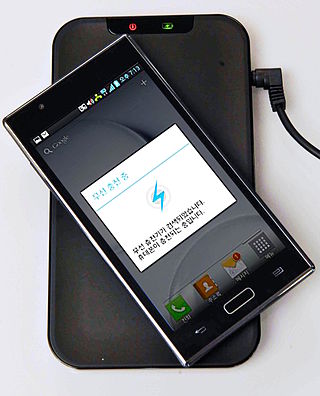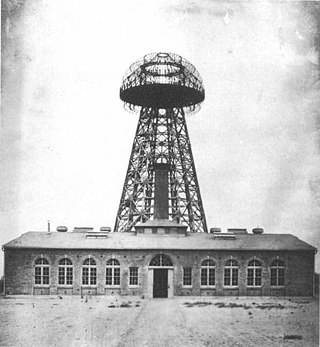Related Research Articles

Electrical engineering is an engineering discipline concerned with the study, design, and application of equipment, devices, and systems that use electricity, electronics, and electromagnetism. It emerged as an identifiable occupation in the latter half of the 19th century after the commercialization of the electric telegraph, the telephone, and electrical power generation, distribution, and use.
An electronic oscillator is an electronic circuit that produces a periodic, oscillating or alternating current (AC) signal, usually a sine wave, square wave or a triangle wave, powered by a direct current (DC) source. Oscillators are found in many electronic devices, such as radio receivers, television sets, radio and television broadcast transmitters, computers, computer peripherals, cellphones, radar, and many other devices.

An amplifier, electronic amplifier or (informally) amp is an electronic device that can increase the magnitude of a signal. It is a two-port electronic circuit that uses electric power from a power supply to increase the amplitude of a signal applied to its input terminals, producing a proportionally greater amplitude signal at its output. The amount of amplification provided by an amplifier is measured by its gain: the ratio of output voltage, current, or power to input. An amplifier is defined as a circuit that has a power gain greater than one.

An optical amplifier is a device that amplifies an optical signal directly, without the need to first convert it to an electrical signal. An optical amplifier may be thought of as a laser without an optical cavity, or one in which feedback from the cavity is suppressed. Optical amplifiers are important in optical communication and laser physics. They are used as optical repeaters in the long distance fiber-optic cables which carry much of the world's telecommunication links.

Harry Nyquist was a Swedish-American physicist and electronic engineer who made important contributions to communication theory.

Photonics is a branch of optics that involves the application of generation, detection, and manipulation of light in the form of photons through emission, transmission, modulation, signal processing, switching, amplification, and sensing.

Power-line communication (PLC) is the carrying of data on a conductor that is also used simultaneously for AC electric power transmission or electric power distribution to consumers. The line that does so is known as a power-line carrier.

In electrical engineering, impedance matching is the practice of designing or adjusting the input impedance or output impedance of an electrical device for a desired value. Often, the desired value is selected to maximize power transfer or minimize signal reflection. For example, impedance matching typically is used to improve power transfer from a radio transmitter via the interconnecting transmission line to the antenna. Signals on a transmission line will be transmitted without reflections if the transmission line is terminated with a matching impedance.

A traveling-wave tube or traveling-wave tube amplifier is a specialized vacuum tube that is used in electronics to amplify radio frequency (RF) signals in the microwave range. It was invented by Andrei Haeff around 1933 as a graduate student at Caltech, and its present form was invented by Rudolf Kompfner in 1942–43. The TWT belongs to a category of "linear beam" tubes, such as the klystron, in which the radio wave is amplified by absorbing power from a beam of electrons as it passes down the tube. Although there are various types of TWT, two major categories are:

In radio communications, a radio receiver, also known as a receiver, a wireless, or simply a radio, is an electronic device that receives radio waves and converts the information carried by them to a usable form. It is used with an antenna. The antenna intercepts radio waves and converts them to tiny alternating currents which are applied to the receiver, and the receiver extracts the desired information. The receiver uses electronic filters to separate the desired radio frequency signal from all the other signals picked up by the antenna, an electronic amplifier to increase the power of the signal for further processing, and finally recovers the desired information through demodulation.

Wireless power transfer is the transmission of electrical energy without wires as a physical link. In a wireless power transmission system, an electrically powered transmitter device generates a time-varying electromagnetic field that transmits power across space to a receiver device; the receiver device extracts power from the field and supplies it to an electrical load. The technology of wireless power transmission can eliminate the use of the wires and batteries, thereby increasing the mobility, convenience, and safety of an electronic device for all users. Wireless power transfer is useful to power electrical devices where interconnecting wires are inconvenient, hazardous, or are not possible.
John Stone Stone was an American mathematician, physicist and inventor. He initially worked in telephone research, followed by influential work developing early radio technology, where he was especially known for improvements in tuning. Despite his often advanced designs, the Stone Telegraph and Telephone Company failed in 1908, and he spent the remainder of his career as an engineering consultant.
This is an alphabetical list of articles pertaining specifically to electrical and electronics engineering. For a thematic list, please see List of electrical engineering topics. For a broad overview of engineering, see List of engineering topics. For biographies, see List of engineers.

Hendrik Wade Bode was an American engineer, researcher, inventor, author and scientist, of Dutch ancestry. As a pioneer of modern control theory and electronic telecommunications he revolutionized both the content and methodology of his chosen fields of research. His synergy with Claude Shannon, the father of information theory, laid the foundations for the technological convergence of the Information Age.

The carbon microphone, also known as carbon button microphone, button microphone, or carbon transmitter, is a type of microphone, a transducer that converts sound to an electrical audio signal. It consists of two metal plates separated by granules of carbon. One plate is very thin and faces toward the speaking person, acting as a diaphragm. Sound waves striking the diaphragm cause it to vibrate, exerting a varying pressure on the granules, which in turn changes the electrical resistance between the plates. Higher pressure lowers the resistance as the granules are pushed closer together. A steady direct current is passed between the plates through the granules. The varying resistance results in a modulation of the current, creating a varying electric current that reproduces the varying pressure of the sound wave. In telephony, this undulating current is directly passed through the telephone wires to the central office. In public address systems it is amplified by an audio amplifier. The frequency response of most carbon microphones, however, is limited to a narrow range, and the device produces significant electrical noise.

Fiber-optic communication is a form of optical communication for transmitting information from one place to another by sending pulses of infrared or visible light through an optical fiber. The light is a form of carrier wave that is modulated to carry information. Fiber is preferred over electrical cabling when high bandwidth, long distance, or immunity to electromagnetic interference is required. This type of communication can transmit voice, video, and telemetry through local area networks or across long distances.
Analogue filters are a basic building block of signal processing much used in electronics. Amongst their many applications are the separation of an audio signal before application to bass, mid-range, and tweeter loudspeakers; the combining and later separation of multiple telephone conversations onto a single channel; the selection of a chosen radio station in a radio receiver and rejection of others.

Electronic engineering is a sub-discipline of electrical engineering that emerged in the early 20th century and is distinguished by the additional use of active components such as semiconductor devices to amplify and control electric current flow. Previously electrical engineering only used passive devices such as mechanical switches, resistors, inductors, and capacitors.

The World Wireless System was a turn of the 20th century proposed telecommunications and electrical power delivery system designed by inventor Nikola Tesla based on his theories of using Earth and its atmosphere as electrical conductors. He claimed this system would allow for "the transmission of electric energy without wires" on a global scale as well as point-to-point wireless telecommunications and broadcasting. He made public statements citing two related methods to accomplish this from the mid-1890s on. By the end of 1900 he had convinced banker J. P. Morgan to finance construction of a wireless station based on his ideas intended to transmit messages across the Atlantic to England and to ships at sea. His decision to change the design to include wireless power transmission to better compete with Guglielmo Marconi's new radio based telegraph system was met with Morgan's refusal to fund the changes. The project was abandoned in 1906, never to become operational.
This glossary of electrical and electronics engineering is a list of definitions of terms and concepts related specifically to electrical engineering and electronics engineering. For terms related to engineering in general, see Glossary of engineering.
References
- ↑ Benjamin F. Shearer (2007). Home Front Heroes: A Biographical Dictionary of Americans During Wartime. Greenwood Publishing Group. pp. 98–99. ISBN 978-0-313-33421-4 . Retrieved March 6, 2013.
He contributed to electrical engineering and system design and received patents for development of transmission networks, transformer systems, electrical wave amplification, and artillery computing.
- ↑ T. K. Sarkar; Robert Mailloux; Arthur A. Oliner; M. Salazar-Palma; Dipak L. Sengupta (January 30, 2006). History of Wireless. John Wiley & Sons. p. 133. ISBN 978-0-471-78301-5 . Retrieved March 6, 2013.
- ↑ National Academy of Engineering (June 1, 1990). Memorial Tributes: National Academy of Engineering. National Academies Press. p. 52. ISBN 978-0-309-03939-0 . Retrieved March 6, 2013.
During World War II, Bode participated in the development of electrical fire control devices, receiving the Presidential Certificate of Merit in 1948 for his contributions. After the ... During his career at Bell, he was granted twenty-five patents for innovations in the areas of transmission networks, ... systems and a general education course on the management and philosophy of the HENDRIK WADE BODE 52.
- ↑ Allen J. Bard; György Inzelt; Fritz Scholz (2012). Electrochemical Dictionary. Springer. pp. 75–76. ISBN 978-3-642-29551-5 . Retrieved March 6, 2013.
Bode, Hendrik Wade 75 across the boundary but in practice this exchange is so slow due to an interfacial barrier that it can be ... He received patents for transmission networks, transformer systems, electrical wave amplification, broadband ...
- ↑ United States. Congress. House. Committee on Science and Astronautics (1965). Hearings . Retrieved March 6, 2013.
Hendrik Wade Bode, research engineer, was born at Madison, Wis., December 24, 1905. He received his B.A. ... Dr. Bode holds patents in the fields of electric circuit theory and military devices. He is author of a book ... He received the Ernest Orlando Lawrence Award in 1960.
- ↑ Hendrik Wade Bode (1959). Network analysis and feedback amplifier design. R. E. Krieger Pub. Co. ISBN 978-0-88275-242-6 . Retrieved March 6, 2013.
Hendrik Wade Bode. We now consider the reactance component in Fig. 16.10. It is obvious that it can be ... The method is given in the author's U. S. Patent No. 2,249,415. It is also possible to remove the pole at infinity. Although this does not ...
- ↑ John W. Leonard; Winfield Scott Downs; M. M. Lewis (1959). Who's who in Engineering. John W. Leonard Corporation. Retrieved March 6, 2013.
Hendrik Wade, Dir. of Research-Physic Sciences, Bell Tel. ... Author: Book, "Network Analysis" a: misc. papers and patents on circuit theory ai military devices.
- ↑ Who was who in America with World Notables. Marquis-Who's Who. 1989. ISBN 9780837902173 . Retrieved March 6, 2013.
BODE, HENDRIK WADE, research engineer, educator, b. Madison. Wis., Dec 24, 1905; s. ... and Technological In- oovauoD m the Bdl System: also tech. papers; holder patents in fields electric cir theory, mil. devices. Mem. vinous govt. mil. adv
- ↑ John Arthur Garraty; Mark Christopher Carnes; American Council of Learned Societies (1999). American national biography. Oxford University Press. ISBN 978-0-19-512782-9 . Retrieved March 6, 2013.
BODE, Hendrik Wade (24 Dec. 1905- ... Bode held a number of patents.
- ↑ Walt Jung (2005). Op Amp Applications Handbook. Newnes. p. 770. ISBN 978-0-7506-7844-5 . Retrieved March 7, 2013.
See also Amplifier:US Patent 2.123.178
- ↑ John R. Koza (1999). Genetic Programming III: Darwinian Invention and Problem Solving : John R.Koza...et Al. Morgan Kaufmann. p. 1084. ISBN 978-1-55860-543-5 . Retrieved March 7, 2013.
Bode, Hendrik W 1931. Transmission Network. U.S. Patent 1,828,454.
- ↑ RCA Review: A Technical Journal ... Radio Corporation of America. 1948. Retrieved March 7, 2013.
1, pp. 17-30, January, 1940. 22 Hendrik W. Bode, United States Patent 2,123,178, July 12, 1938.
- ↑ United States. Congress. House. Committee on Science and Astronautics; National Academy of Sciences (U.S.). Special Panel on Applied Science and Technological Progress (1967). Presentation of report by Special Panel on Applied Science and Technological Progress of the National Academy of Sciences: Hearing, Ninetieth Congress, first session. May 25, 1967. U.S. Govt. Print. Off. Retrieved March 7, 2013.
HENDRIK W. BODE Hendrik W. Bode, research engineer, was born in Madison, Wisconsin, December 24, 1905. He earned his B.A, at Ohio ... He holds a number of patents in electric circuit theory and military devices. Dr. Bode received the...
- ↑ He has been granted 25 patents in electrical engineering and systems design, including patents for transmission networks, transformer systems, electrical wave amplification, broadband amplifiers, and artillery computing IEEE website
- ↑ He is the author of Network Analysis and Feedback Amplifier Design (1945), and holds several patents on electrical engineering and systems design. The Harvard Crimson